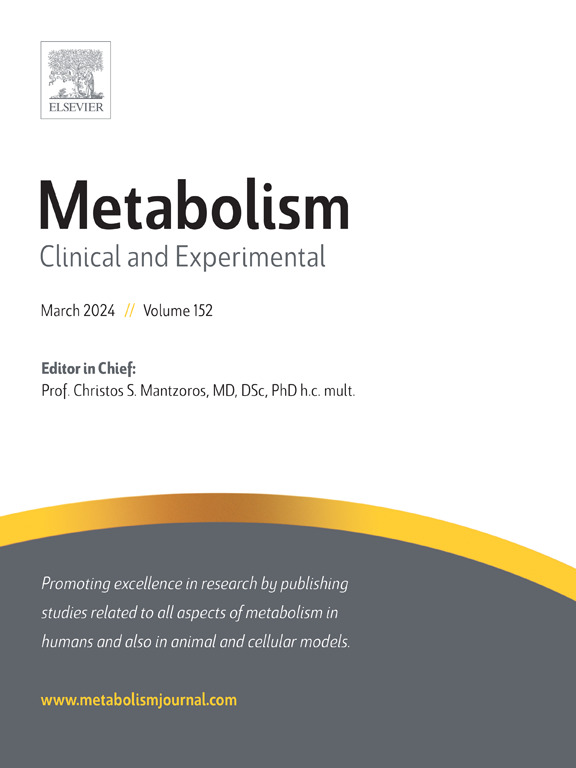Flot2 protects against podocyte injury by maintaining the stability of synaptopodin in diabetic nephropathy
IF 11.9
1区 医学
Q1 ENDOCRINOLOGY & METABOLISM
引用次数: 0
Abstract
Podocyte injury is a major determinant of diabetic nephropathy (DN). Critical structural proteins such as synaptopodin play an important role in maintaining podocyte morphology and function. Herein, we uncover a protective role of Flotillin-2 (Flot2), a lipid microdomain-associated protein, in the development of DN by maintaining the stability of synaptopodin. We found that Flot2 was downregulated in podocytes and its expression was correlated with glomerular filtration rate and proteinuria in patients with DN. Functionally, Flot2 is protective in DN as global and podocyte-specific Flot2 knockout (KO) worsened podocyte injury and aggravated the disease as demonstrated by increasing albuminuria, thickening of glomerular basement membrane, and expansion of mesangium matrix in diabetic mice. In contrast, podocyte-specific Flot2 overexpression ameliorated diabetes-induced renal dysfunction and pathology. Mechanistically, we found that Flot2 directly interacted with synaptopodin and protected synaptopodin from ubiquitin degradation via the K48-linked polyubiquitination mediated proteasome pathway. Thus, our findings demonstrate that Flot2 is protective in DN and exerts its protective role by stabilizing synaptopodin. Targeting Flot2 may be a potential therapeutic approach in DN.

在糖尿病肾病中,Flot2通过维持synaptopodin的稳定性来保护足细胞免受损伤。
足细胞损伤是糖尿病肾病(DN)的主要决定因素。关键结构蛋白如synaptopodin在维持足细胞形态和功能方面起着重要作用。在此,我们揭示了flotilin -2 (Flot2),一种脂质微结构域相关蛋白,通过维持synaptopodin的稳定性在DN的发展中起保护作用。我们发现足细胞中Flot2表达下调,其表达与DN患者肾小球滤过率和蛋白尿相关。在功能上,Flot2对DN具有保护作用,因为糖尿病小鼠的蛋白尿增加、肾小球基底膜增厚和系膜基质扩张表明,Flot2基因敲除(KO)会加重足细胞损伤并加重疾病。相反,足细胞特异性Flot2过表达可改善糖尿病引起的肾功能障碍和病理。在机制上,我们发现Flot2直接与synaptopodin相互作用,并通过k48连接的多泛素化介导的蛋白酶体途径保护synaptopodin免受泛素降解。因此,我们的研究结果表明,Flot2在DN中具有保护作用,并通过稳定synaptopodin发挥其保护作用。靶向Flot2可能是DN的潜在治疗方法。
本文章由计算机程序翻译,如有差异,请以英文原文为准。
求助全文
约1分钟内获得全文
求助全文
来源期刊

Metabolism: clinical and experimental
医学-内分泌学与代谢
CiteScore
18.90
自引率
3.10%
发文量
310
审稿时长
16 days
期刊介绍:
Metabolism upholds research excellence by disseminating high-quality original research, reviews, editorials, and commentaries covering all facets of human metabolism.
Consideration for publication in Metabolism extends to studies in humans, animal, and cellular models, with a particular emphasis on work demonstrating strong translational potential.
The journal addresses a range of topics, including:
- Energy Expenditure and Obesity
- Metabolic Syndrome, Prediabetes, and Diabetes
- Nutrition, Exercise, and the Environment
- Genetics and Genomics, Proteomics, and Metabolomics
- Carbohydrate, Lipid, and Protein Metabolism
- Endocrinology and Hypertension
- Mineral and Bone Metabolism
- Cardiovascular Diseases and Malignancies
- Inflammation in metabolism and immunometabolism
 求助内容:
求助内容: 应助结果提醒方式:
应助结果提醒方式:


